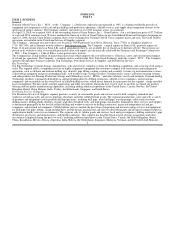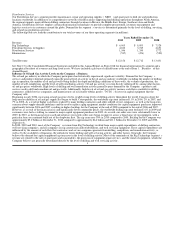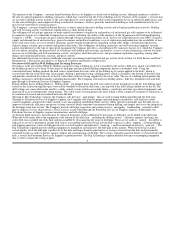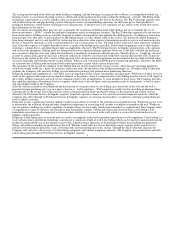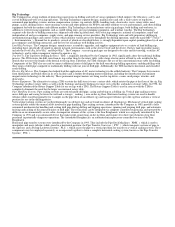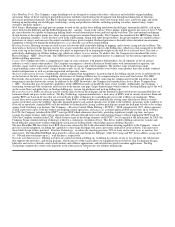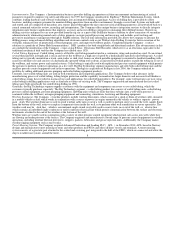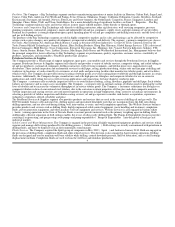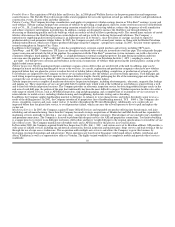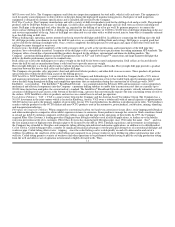National Oilwell Varco 2010 Annual Report Download - page 5
Download and view the complete annual report
Please find page 5 of the 2010 National Oilwell Varco annual report below. You can navigate through the pages in the report by either clicking on the pages listed below, or by using the keyword search tool below to find specific information within the annual report.
The raising and lowering of the drill stem while drilling or tripping, and the lowering of casing into the wellbore, is accomplished with the rigs
hoisting system. A conventional hoisting system is a block and tackle mechanism that works within the drilling rigs derrick. The lifting of this
mechanism is performed via a series of pulleys that are attached to the drawworks at the base of the derrick. The Rig Technology segment sells
and installs drawworks and pipe hoisting systems. During the course of normal drilling operations, the drill stem passes through different
geological formations, which exhibit varying pressure characteristics. If this pressure is not contained, oil, gas and/or water would flow out of
these formations to the surface.
The two means of containing these pressures are (i) primarily the circulation of drilling muds while drilling and (ii) secondarily the use of
blowout preventers (BOPs) should the mud prove inadequate and in an emergency situation. The Rig Technology segment sells and services
blowout preventers. Drilling muds are carefully designed to exhibit certain qualities that optimize the drilling process. In addition to containing
formation pressure, they must (i) provide power to the drilling motor, (ii) carry drilled solids to the surface, (iii) protect the drilled formations
from being damaged, and (iv) cool the drill bit. Achieving these objectives often requires a formulation specific to a given well and can involve
the use of expensive chemicals as well as natural materials such as certain types of clay. The fluid itself is often oil or more expensive synthetic
mud. Given this expense, it is highly desirable to reuse as much of the drilling mud as possible. Solids control equipment such as shale shakers,
centrifuges, cuttings dryers, and mud cleaners help accomplish this objective. The Petroleum Services & Supplies segment rents, sells, operates
and services this equipment. Drilling muds are formulated based on expected drilling conditions. However, as the hole is drilled, the drill stem
may encounter a high pressure zone where the mud density is inadequate to maintain sufficient pressure. Should efforts to weight up the mud
in order to contain such a pressure kick fail, a blowout could result, whereby reservoir fluids would flow uncontrolled into the well. To prevent
blowouts to the surface of the well, a series of high-pressure valves known as blowout preventers are positioned at the top of the well and, when
activated, form tight seals that prevent the escape of fluids. When closed, conventional BOPs prevent normal rig operations. Therefore, the BOPs
are activated only if drilling mud and normal well control procedures cannot safely contain the pressure.
The operations of the rig and the condition of the drilling mud are closely monitored by various sensors, which measure operating parameters
such as the weight on the rigs hook, the incidence of pressure kicks, the operation of the drilling mud pumps, etc. Through its Rig Technology
segment, the Company sells and rents drilling rig instrumentation packages that perform these monitoring functions.
During the drilling and completion of a well, there exists an ongoing need for various consumables and spare parts. While most of these items are
small, in the aggregate they represent an important element of the process. Since it is impractical for each drilling location to have a full supply of
these items, drilling contractors and well service companies tend to rely on third parties to stock and deliver these items. The Company provides
this capability through its Distribution Services segment, which stocks and sells spares and consumables made by third parties, as well as spares
and consumables made by the Company.
After the well has reached its total depth and the final section of casing has been set, the drilling rig is moved off of the well and the well is
prepared to begin producing oil or gas in a process known as well completion. Well completion usually involves installing production tubing
concentrically in the casing. Due to the corrosive nature of many produced fluids, production tubing is often inspected and coated, services
offered by the Petroleum Services & Supplies segment. Sometimes operators choose to use corrosion resistant composite materials, which the
Company also offers through its Petroleum Services & Supplies segment, or corrosion-resistant alloys, or operators sometimes pump fluids into
wells to inhibit corrosion.
From time to time, a producing well may undergo workover procedures to extend its life and increase its production rate. Workover rigs are used
to disassemble the wellhead, tubing and other completion components of an existing well in order to stimulate or remediate the well. Workover
rigs are similar to drilling rigs in their capabilities to handle tubing, but are usually smaller and somewhat less sophisticated. The Company offers
a comprehensive range of workover rigs through its Rig Technology segment. Tubing and sucker rods removed from a well during a well
remediation operation are often inspected to determine their suitability to be reused in the well, which is a service the Petroleum Services &
Supplies segment provides.
Frequently coiled tubing units or wireline units are used to accomplish certain well remediation operations or well completions. Coiled tubing is a
recent advancement in petroleum technology consisting of a continuous length of reeled steel tubing which can be injected concentrically into the
production tubing all the way to the bottom of most wells. It permits many operations to be performed without disassembling the production
tubing, and without curtailing the production of the well. Wireline winch units are devices that utilize single-strand or multi-strand wires to
perform well remediation operations, such as lowering tools and transmitting data to the surface. Through the Rig Technology segment, the
Company sells and rents various types of coiled tubing equipment, and wireline equipment and tools. The Company also manufactures and sells
coiled tubing pipe through its Petroleum Services & Supplies segment. 5


